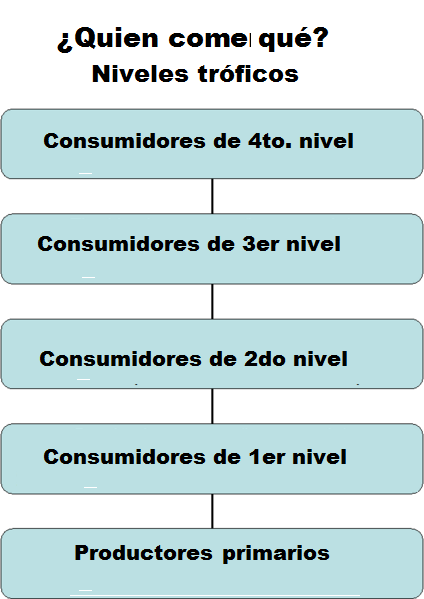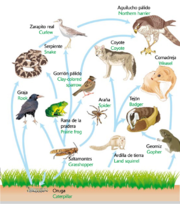¿Quién come qué?
Contenido
- 1 Quién come que?
- 1.1 Calificación de los alumnos
- 1.2 Biología 1er ciclo
- 1.3 Materiales
- 1.4 Handouts
- 1.5 Description of activity
- 1.6 Lesson plan
- 1.7 Problemas potenciales
- 1.8 Transversales con Artes plásticas
- 1.9 Literature connections
- 1.10 Connections to educational standards
- 1.11 Next steps
- 1.12 Citations and links
- 1.13 Reflections
Quién come que?
Calificación de los alumnos
Tested
Biología 1er ciclo
Niveles tróficos de la cadena alimentaria
Materiales
Materiales necesarios para el profesor:
- Esquema de los niveles tróficos e ilustraciones
- Ejemplo de cadena trófica
Materiales que cada alumno requerirá
- Revistas con animales (vg. National Geographic, Scientific American)
- Tijeras
- Pegamento en barra
- papel Kraft
Handouts
See Below.
Description of activity
First the teacher will explain the 5 trophic levels of a food chain to the students using the hand out with the sample food chain (Figure 1). Then once they have learned about trophic levels, autotrophs, and heterotrophs, each student can begin looking through the magazines and cutting out pictures of animals to create their own food chain. Once each student has completed his or her food chain, you can have them share them with the group.
Lesson plan
- Hand out the reference page of the trophic levels (figure 1) to each student.
- First explain the difference between an autotroph and a hetertroph.
- Verify that they know the differences between carnivores, omnivores, and herbivores.
- Next go through each level making sure that each student understands the characteristics of each.
- Provide magazines and scissors for each student to cut out organisms for his or her food chain.
- Once they have finished cutting pass out the glue sticks and construction paper and have each student glue his or her food chain to the construction paper.
- Next have them label each level of their food chain.
- Ask students to share their food chains in small groups.
Problemas potenciales
Algunos problemas que peudes encotrar es léxica y la confusión de distinguir entre los diferentes niveles tróficos.
Transversales con Artes plásticas
Los alumnos harán dibujos de algunos animales mejorando sus experiencias en artes visuales.
Literature connections
Babies in the Bayou by Jim Arnosky
Connections to educational standards
Visual Arts – 5.29 Students use the elements and principles of two and three dimensional design in the visual arts, including line, color, shape, and texture, in creating, viewing, and critiquing.
Organisms, Evolution, and Interdependence – 7.13 Students understand the characteristics of organisms, see patterns of similarity and differences among living organisms, understand the role of evolution, and recognize the interdependence of all systems that support life.
Next steps
Once you have covered a simple food chain or web you may continue the lesson by talking about different relationship between animals other than predator and prey situations. For instance relationships that benefit both organisms could be explored.
Citations and links
http://www.instructorweb.com/lesson/animals.asp This website would be very helpful when looking for handouts or a follow up activity.
Reflections
This lesson was very interesting for us to do because it produced many questions by the students that also challenged us. One of the questions that was asked numerous times was whether or not elephants eat other animals like a monkey or something along those lines. The challenge was not in the answer here but rather once we told them that they did not and that they only eat leaves and smaller things, they wanted to know how elephants got so big if all they ate were plants. This was a challenge for us to explain to them. It was also interesting to see how some students took the initiative to make their food webs very complex while others barely finished the bear minimum. We were a little pressed for time though I feel like a half an hour would have been sufficient but only twenty minutes was a little more difficult.
We have recently received feedback from the classroom teacher that we work with on the lesson and she has told us that having the list of vocabulary was crucial to the project itself. She said that many times, students just need the confidence of having the words next to the to look at whenever they need to rather than constantly having to ask how to spell something. Many students may not be confident in themselves or are too shy to ask in the fir



